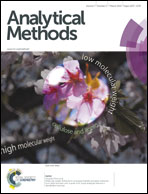Biofunctionalized dendritic polyaniline nanofiber for in situ amplified glucometer-based enzyme immunoassay of tumor marker
Abstract
This work reports on a new electrochemical enzyme immunoassay for sensitive detection of a disease-related protein (alpha-fetoprotein, AFP, used as a model target analyte) at a low concentration by using a biofunctional dendritic polyaniline nanofiber as the signal-transduction tag. The signal was amplified on the basis of glucoamylase-labeled, multi-armed dendritic polyaniline nanofiber conjugated with anti-AFP detection antibody. The assay was carried out on an anti-AFP capture antibody-coated microplate with a sandwich-type immunosensing protocol and monitored by a portable personal glucometer (PGM). Accompanying formation of the sandwich immunocomplex in the microplate, the glucoamylase carried by the nanofiber could hydrolyze amylopectin into glucose, and the as-produced glucose could be determinated by the PGM. The detectable signal increased with the increasing target AFP concentration in the sample and exhibited a wide dynamic range of 0.1–50 ng mL−1 with a low detection limit of 0.03 ng mL−1 at a S/N = 3. Meanwhile, the PGM-based enzyme immunoassay displayed high reproducibility and specificity. The assay results for 15 human serum specimens with the PGM-based immunoassay gave data that well matched those obtained from the referenced enzyme-linked immunosorbent assay (ELISA) method.


 Please wait while we load your content...
Please wait while we load your content...